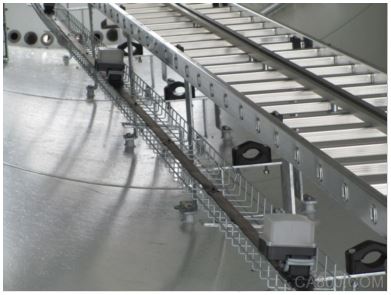
Wind turbine tower electrical systems are usually installed in the traditional way. Lighting fixtures, maintenance sockets, and emergency lighting systems need to be connected to the respective installation locations. However, there is now a more economical, fast, and reliable method. This is an innovative modular installation solution specially designed by Weiyi Electric for the fan tower.
In recent decades, the electrical installation of wind turbine towers has remained unchanged. Lighting fixtures, maintenance outlets, and emergency lighting systems are all installed and wired using traditional wiring methods. The tower manufacturer manufactured the towers in horizontal sections and invited their own professionals to connect each section together. These professionals are also responsible for installing other tower accessories such as ladders and platforms. Although this kind of electrical installation is clearly defined, it is not only expensive, it is difficult to calculate costs, and unfortunately it is also easy to make mistakes.
Wieland's podis® plug-in power bus solution is not only more cost-effective and faster to install, but also modular design makes it highly adaptable to different tower designs. Its components have a variety of international certifications and are suitable for particularly harsh environments.
The podis® system consists of a flat cable power bus and pluggable function modules mounted directly on the cable. It has been successfully applied in various industries for many years and provides innovative solutions for the increasingly expanding logistics and material handling systems. The podis® system is not only used in airport baggage transfer lines around the world, but also has mature applications in the transmission lines of the automotive industry, the assembly and packaging of conveyor belts, and distribution systems in the logistics industry.
Since 2011, this mounting system has also been used as a standard design by major tower manufacturers. The main reason is the enormous economic benefits it brings, the efficient electrical project management and electrical installation techniques, as well as the convenience of operation and maintenance.
Past ways
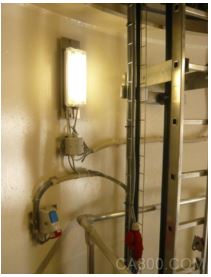
Complex and expensive:
Conventional installations still in use today
Starting point: The interior of the wind turbine needs to install lamps that meet the standards and reach the corresponding illumination. In order to ensure that maintenance personnel can safely move the fan up and down even in an emergency. For a long time, for emergency lighting, the industry's common practice is to use fluorescent lamps with built-in batteries. Fixtures are fixed on the auxiliary mounting plate, and the mounting plate is mounted on the tower wall by welding studs or mounted directly on the ladder through a special bracket. In each tower section, the maintenance outlet also has its own power cord. The entire tower is usually installed with up to 20 lights and 5 to 10 maintenance sockets. The traditional wiring method can not be quickly checked when an installation error occurs. Under the pressure of the construction period, manufacturers must erect the tower as soon as possible. However, errors in assembly often lead to delays in delivery and commissioning, which in turn leads to increased costs. In addition, fluorescent lamps and their batteries do not work well in low temperature environments, as well as extended storage or transportation times. Fluorescent lamps require additional heating at operating temperatures below -20°C.
During the months of tower transport and storage, many batteries were damaged before installation and commissioning because of the inevitable discharge of the batteries. In addition, there are a variety of different requirements from customers, countries, or special certification bodies that cause tower builders to incur more costs when making mechanical and electrical modifications.
This creates a clear need to minimize expensive costs through simple electrical installations. Power Electronics' plug-in power bus solution, podis®, is a new type of system that can significantly reduce project management, installation and maintenance costs.
Solutions podis® Power Bus
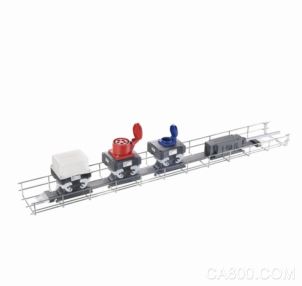
The backbone of the podis® system is a factory tested multi-core flat cable. It can be partially pre-manufactured and delivered according to the specific project of the tower manufacturer and then installed in stages. In the tower assembly field, the podis® system can be plugged together very easily. A worker with a certain technical basis can perform such operations without the need for specially trained electrical engineers or electricians. The new podis® fixtures are equipped with more energy-efficient and stable high-power LED lamp beads.
The podis® system is an economical solution, especially for steel fan towers. Steel fan towers are generally divided into three to five sections, each about 20 to 25 meters in length. Concrete towers consist of a large number of annular or semi-annular precast concrete modules, or temporary concrete molds are used on site. Deterrence provides a perfect solution for both steel and concrete towers. Plug-in electrical installation of standard round cables is possible with prefabricated plug-in gesis® lP+ systems.
The podis® system product provides a uniquely designed direct-mounted plug-in function module for wind turbine towers. These modules are equipped with internationally recognized power outlets (including NEMA GFCI and CEE) as well as LED lights. Step-by-step installation is simple and straightforward.
Base module quickly mounted on cable tray

1. Engage the module on the bridge 2. Bend the mounting feet to fix the module

3. Install the flat cable with mechanical coding 4. Connect the terminal via the puncture screw
First, the module is snapped onto the bridge, then the mounting feet are bent, the module is fixed, then the flat cable with the mechanical coding is installed and then the electrical connection is made through the piercing screw. Finally, insert the functional module into the base. This installation method reduces total installation time by about 70%. At the same time unique mechanical coding guarantees an error-free connection of cables and components.
Simple, safe and fast installation
Electrical installation consists of three parts. First, a flexible power bus is installed on the bridge of each tower section and fixed with a nylon tie. This power bus consists of a 7-pin flat cable that can be used for both 400VAC and 24VDC power supplies. The bus is encoded in an asymmetrical form, and the fault-tolerant design makes the installation more reliable. Install insulated cable ends on both ends of the flat cable after installation. Afterwards, the power take-up base modules are placed and connected along the flat cables, which are used to mount the lamps or sockets. The final step inserts the required function module into the base and fastens it with two quick spring catches, such as LED luminaires (regular lighting and emergency lighting), or maintenance sockets.
The connection between the two tower sections is realized by a feed module. This module is prefabricated with a functional module and an extended round cable. The open end of the round cable is connected to the upper part of the other tower section. The functional module is mounted on the last power take-up base at the bottom of the tower section and secured by a mechanical lock.
One of the advantages of the podis® system is that it replaces the stripping, wiring, and tension and shielding tests of laborious, time-consuming, error-prone individual cables. The extremely robust functional module housing provides IP65 protection for the entire system's connection, making it ideal for outdoor or harsh industrial environments.
Flat cables need to be handled at both ends of the tower section only. This greatly reduces the possibility of installation errors. Any fault can only exist in a separate functional module, not the entire installation system. This greatly simplifies troubleshooting and prevents secondary costs due to fault propagation.
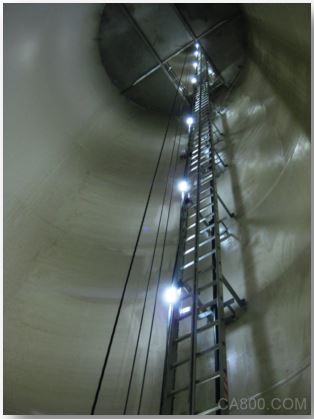
The figure shows a section of a steel tower equipped with podis® components (flat cable, plug-in LED lights and maintenance sockets)
LED lamps are reliable, durable, and energy-efficient
High-power LED lamps are used for tower lighting. This approach replaced the original standard built-in battery fluorescent emergency lighting. LED lamps have ten times longer life than fluorescent lamps.
They do not require maintenance and can instantly switch to maximum brightness even at low temperatures. Since the operating temperature of the podis® LED lamp is -40 to +70°C, Wieland Electric's LED lamps can be used in the CCV (cold weather version) and HCV (hot weather version) temperature ranges.
According to DIN EN 60598-2-22, the luminaires use a centralized power supply for the emergency lighting state. Each 24VDC powered luminaire consumes less than 5W. The centralized battery solution makes the task of replacing the battery on a periodic basis simple and saves money and time. Podis®, which means that even if the tower height exceeds 100 meters, the pressure drop can be avoided.
Impact on full lighting power.
Result: The reliability of emergency lighting must be ensured even in the event of a malfunction. Since each luminaire is integrated with short circuit and overload protection, the fault will be quickly located and will not spread. During maintenance or service, the compact LED light can be replaced without tools and supports hot swap. All function modules and lights are plugged directly into the standard power take-up base module and can be replaced quickly and easily.
Compared to fluorescent lighting, LED technology ensures that the tower lighting is at the same level from beginning to end, meeting the minimum requirements of the standard 10 Lux. The distribution pattern of the lighting is also adjusted according to the cylindrical geometry of the tower. The frosted light guide plate ensures a stable, non-glare lighting environment for the ladder.
Use of global wind turbines and offshore wind turbines
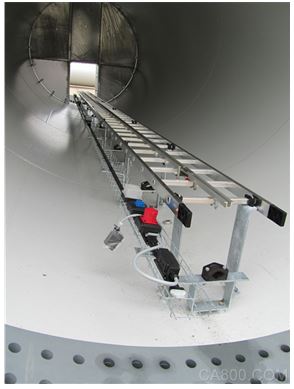
The fan tower can be installed with a complete flat cable and LED fixture to increase installation efficiency and optimize lighting solutions.
Above: Factory prefabricated tower section, ready to connect at construction site
Wieland's podis® power bus solution has passed UL certification so it can be used in the North American market. According to UL, tower mounting requires only a few components to be replaced, and the modular mechanical structure is not affected, that is, only UL-approved XLPE cables can be used instead of EVA flat cables. The same podis® power take-up base is suitable for functional modules with NEMA sockets. The UL certification of the new podis® LED lamp and NEMA socket module is in process.
The next step is that the podis® system will be certified as a offshore system.
For this purpose, the system components have been submitted to the German Lloyd's Register of Shipping for design registration. And will pass the salt spray, corrosion grade C4 and other tests to ensure the reliable operation of the system under harsh conditions.
Dipl.-Ing. Stefan Kadur, Global Industry Manager WindPower
Dipl.-Ing. Meinrad Braun, Productmanager podis®
Background information
Established in 1910, Wieland Bamberg Electric was one of the pioneers of electrical connection technology. Its product range far exceeds 2000 industrial automation components, and construction installation and automation. With its gesis® system deterrence has been installed in the world market leader pluggable building electrical for 30 years.
The podis® distributed power distribution system is designed for automation solutions. The modular system effectively accommodates decentralized installations, especially for logistics and material handling systems.
Deterrence is a family-owned company operating globally. Its subsidiaries and sales organizations exceed Argentina, Belgium, China, Denmark, Germany, France, the United Kingdom, Italy, Canada, the Philippines, Poland, Romania, Russia, Spain, the Czech Republic and the United States. More than 70 countries.
STOCKO GmbH & Co. KG has been part of the Wieland Group since 1998. Wieland Electric accredits ISO 9001:2008, ISO 14001 and the EU eco-audit program/audit system in accordance with quality and environmental management systems.
Rear Rack Battery,Lithium Battery Pack,Electric Bicycle Battery 48V,Electric Icycle Lithium Batteries
Changxing Deli Technology Co., Ltd. , https://www.delipowers.com